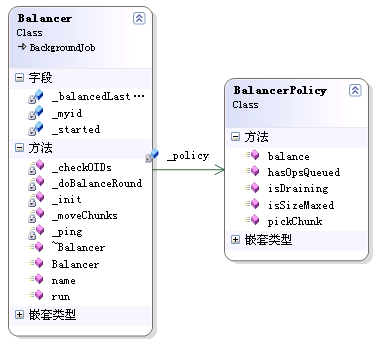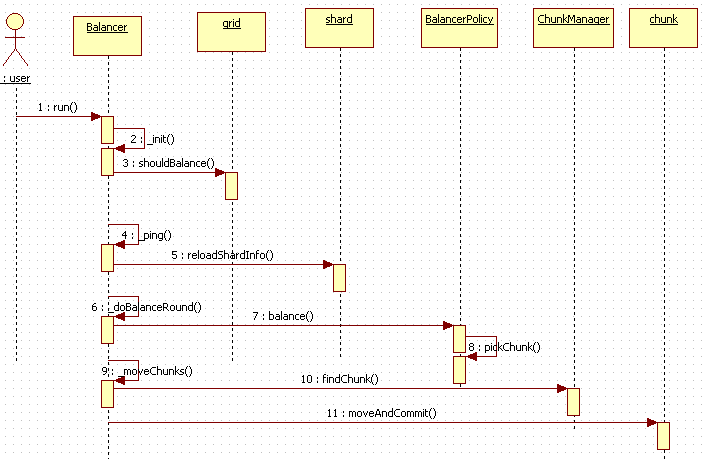在之前的一篇文章 中,介绍了mongos的启动流程,在那篇文章的结尾,介绍了mongos使用balancer来进行均衡,今天就继续讲其实现方式。
首先我们看一下Balancer及相关实现策略的类图:

可以看到Balancer类里包含一个BalancerPolicy,其指向一个均衡策略,该策略会实现查找并收集要迁移的chunk。
这里先看一下Balancer的类定义,如下:
class Balancer : public BackgroundJob {
public :
Balancer();
virtual ~ Balancer();
// BackgroundJob methods
virtual void run();
virtual string name() const { return " Balancer " ; }
private :
typedef BalancerPolicy::ChunkInfo CandidateChunk;
typedef shared_ptr < CandidateChunk > CandidateChunkPtr;
// mongos名称(hostname:port)
string _myid;
// Balancer 启动时间
time_t _started;
// 前移的chunks数量
int _balancedLastTime;
// 均衡策略(确定要迁移的chunks)
BalancerPolicy * _policy;
// 初始化,检查balancer 能否链接到servers.该方法可能抛出网络异常
bool _init();
/* *
* 收集关于shards及chunks的信息,以及可能需要迁移的chunks
* @param conn: 指向config server(s)连接
* @param candidateChunks (IN/OUT): 可能需要迁移的chunks
*/
void _doBalanceRound( DBClientBase & conn, vector < CandidateChunkPtr >* candidateChunks );
/* *
* 逐个迁移chunk.并返回最终迁移的chunk数量
* @param candidateChunks 可能需要迁移的chunks
* @return number of chunks effectively moved
*/
int _moveChunks( const vector < CandidateChunkPtr >* candidateChunks );
/* 在config server(s)中标记并前balancer为活动状态. */
void _ping( DBClientBase & conn );
// 当configdb中的所有服务均可用时,返回true
bool _checkOIDs();
};
可以看出balancer继承自BackgroundJob,所以它是以后台方式运行的。了解了该类的方法和属性之后,下面我们着手看一下mongos 主函数中启动balancer.go()的调用流程。因为balancer继承自BackgroundJob,所以还要看一下BackgroundJob 里go()方法的执行代码, 如下:
BackgroundJob & BackgroundJob::go() {
boost::thread t( boost::bind( & BackgroundJob::jobBody , this , _status ) );
return * this ;
}
/// /background.cpp. Background object can be only be destroyed after jobBody() ran
void BackgroundJob::jobBody( boost::shared_ptr < JobStatus > status ) {
....
const string threadName = name();
if ( ! threadName.empty() )
setThreadName( threadName.c_str() );
try {
run(); // 到这里,mongos开始执行子类balancer中的run方法
}
....
if ( status -> deleteSelf )
delete this ;
}
上面代码最终会将执行流程转到balancer类的run()方法,如下
/* this is the body of a BackgroundJob so if we throw
here we're basically ending the balancer thread prematurely */
while ( ! inShutdown() ) {
if ( ! _init() ) { // 检查balancer是否链到config server和其它shard上
log() << " will retry to initialize balancer in one minute " << endl;
sleepsecs( 60 );
continue ;
}
break ;
}
ConnectionString config = configServer.getConnectionString();
// 声明分布式锁
DistributedLock balanceLock( config , " balancer " );
while ( ! inShutdown() ) { // 一直循环直到程序中断或关闭
try {
// 判断chunk均衡功能是否有效
if ( ! grid.shouldBalance() ) {
log( 1 ) << " skipping balancing round because balancing is disabled " << endl;
sleepsecs( 30 );
continue ;
}
// 从链接池中获取一个链接对象,如无链接则直接创建。更多内容详见connpool.cpp文件的
// DBClientBase* DBConnectionPool::get(const string& host) 方法.
ScopedDbConnection conn( config );
_ping( conn.conn() ); // 标识链到config server的balancer为活动(live)状态
if ( ! _checkOIDs() ) {
uassert( 13258 , " oids broken after resetting! " , _checkOIDs() );
}
// 重载Shard集合信息(shard 状态)
Shard::reloadShardInfo();
if ( ! lk.got() ) {
log( 1 ) << " skipping balancing round because another balancer is active " << endl;
conn.done();
sleepsecs( 30 ); // no need to wake up soon
continue ;
}
log( 1 ) << " *** start balancing round " << endl;
vector < CandidateChunkPtr > candidateChunks;
// 获取在shard集合中建议迁移的chunk信息(包含要迁移到的目标shard信息)
_doBalanceRound( conn.conn() , & candidateChunks );
if ( candidateChunks.size() == 0 ) { // 是否有要移动的chunk
log( 1 ) << " no need to move any chunk " << endl;
}
else // 开始迁移并返回最终迁移数量 {
_balancedLastTime = _moveChunks( & candidateChunks );
}
log( 1 ) << " *** end of balancing round " << endl;
conn.done(); // 将conn放到链接池中(为其它后续操作使用)
sleepsecs( _balancedLastTime ? 5 : 10 );
}
catch ( std::exception & e ) {
log() << " caught exception while doing balance: " << e.what() << endl;
// Just to match the opening statement if in log level 1
log( 1 ) << " *** End of balancing round " << endl;
sleepsecs( 30 ); // sleep a fair amount b/c of error
continue ;
}
}
}
上面方法中主要是先构造链接串,进而构造连接实例(注:这里使用了链接池的概念,我会在后续章节中专门介绍其实现机制)。之后刷新sharding中的 相关信息(确保其有效性),之后调用_doBalanceRound()方法来收集可能要迁移的chunk(s)信息并最终完成迁移(使用 _moveChunks方法)。
下面我们就着重看一下这两个方法的具体实现.
首先是_ doBalanceRound 方法:
void Balancer::_doBalanceRound( DBClientBase & conn, vector < CandidateChunkPtr >* candidateChunks ) {
assert( candidateChunks );
// 1. 通过查询ShardsNS::collections来检查是否有可用sharded集合来均衡chunk
auto_ptr < DBClientCursor > cursor = conn.query( ShardNS::collection , BSONObj() );
vector < string > collections;
while ( cursor -> more() ) {
BSONObj col = cursor -> next();
// sharded collections will have a shard "key".
if ( ! col[ " key " ].eoo() )
collections.push_back( col[ " _id " ].String() );
}
cursor.reset();
if ( collections.empty() ) {
log( 1 ) << " no collections to balance " << endl;
return ;
}
// 获取一个需要均衡的shard信息列表,表中shard信息包括maxsize, currsiez, drain, hsopsqueued
vector < Shard > allShards;
Shard::getAllShards( allShards );
if ( allShards.size() < 2 ) {
log( 1 ) << " can't balance without more active shards " << endl;
return ;
}
// 获取allShards的相应状态信息交绑定到shardLimitMap相应元素中,该shardLimitMap是一个从shardId到对象(BSONObj)的映射
map < string , BSONObj > shardLimitsMap;
for ( vector < Shard > ::const_iterator it = allShards.begin(); it != allShards.end(); ++ it ) {
const Shard & s = * it;
ShardStatus status = s.getStatus();
LimitsFields::currSize( status.mapped() ) << // 当前时间状态的信息
hardFields::draining( s.isDraining() ) << // 当前的shard是否正在被移除
LimitsFields::hasOpsQueued( status.hasOpsQueued() ) // 是否有回写的队列信息
);
shardLimitsMap[ s.getName() ] = limitsObj;
}
// 遍历collections集合,根据均衡策略(balancing policy) ,检查是否有要迁移的chunk信息
for (vector < string > ::const_iterator it = collections.begin(); it != collections.end(); ++ it ) {
const string & ns = * it; // 集合的名空间
map < string ,vector < BSONObj > > shardToChunksMap; // 从shardId 到chunks 的映射
cursor = conn.query( ShardNS::chunk , QUERY( " ns " << ns ).sort( " min " ) );
while ( cursor -> more() ) {
BSONObj chunk = cursor -> next();
// 以chunk所属的shard为标识,获取一个chunks的集合来收集位于同一shard的chunk
vector < BSONObj >& chunks = shardToChunksMap[chunk[ " shard " ].String()];
chunks.push_back( chunk.getOwned() );
}
cursor.reset();
if (shardToChunksMap.empty()) {
log( 1 ) << " skipping empty collection ( " << ns << " ) " ;
continue ;
}
for ( vector < Shard > ::iterator i = allShards.begin(); i != allShards.end(); ++ i ) {
// this just makes sure there is an entry in shardToChunksMap for every shard
Shard s = * i;
shardToChunksMap[s.getName()].size();
}
// 找出要迁移的chunk,包括源及目标(要迁移到的)chunk的起始地址
CandidateChunk * p = _policy -> balance( ns , shardLimitsMap , shardToChunksMap , _balancedLastTime /* number of moved chunks in last round */ );
if ( p ) candidateChunks -> push_back( CandidateChunkPtr( p ) ); // 存到要均衡的chunk集合中
}
}
上面的_doBalanceRound方法主要构造shardLimitsMap,shardToChunksMap这两个实例对象集合(map<>类型),其中:
shardLimitsMap :用于收集shard集合中一些“起数量限制”作用的参数,如maxsize,draining,hasOpsQueued等,因为这几个参数如果超出范围或为true时,相应shard 是不可以提供迁移服务的。
shardToChunksMap :用于收集当前shard中的chunk信息,以便后面的遍历操作。
收集了这些信息之后,通过调用 _policy->balance()方法来找出可能需要迁移的chunk().
下面就看一下该均衡策略的具体实现(具体内容参见注释):
BalancerPolicy::ChunkInfo * BalancerPolicy::balance( const string & ns,
const ShardToLimitsMap & shardToLimitsMap,
const ShardToChunksMap & shardToChunksMap,
int balancedLastTime ) {
pair < string ,unsigned > min( "" ,numeric_limits < unsigned > ::max());
pair < string ,unsigned > max( "" , 0 );
vector < string > drainingShards;
// 遍历shard集合,找到min,max的匹配对象,以及draining的Shard信息
for (ShardToChunksIter i = shardToChunksMap.begin(); i != shardToChunksMap.end(); ++ i ) {
// 遍历shard,并查看其容量或可用空间是否被耗尽
const string & shard = i -> first;
BSONObj shardLimits;
ShardToLimitsIter it = shardToLimitsMap.find( shard );
if ( it != shardToLimitsMap.end() ) shardLimits = it -> second; // 获取shard的信息,包括maxsize, currsiez, drain, hsopsqueued
const bool maxedOut = isSizeMaxed( shardLimits ); // shard是否已满
const bool draining = isDraining( shardLimits ); // shard是否移除
const bool opsQueued = hasOpsQueued( shardLimits ); // shard是否有写回队列
// 是否合适接收chunk,满足下面三个条件之一,则视为不合适
// + maxed out shards
// + draining shards
// + shards with operations queued for writeback
const unsigned size = i -> second.size(); // 获取当前shard里的chunk数
if ( ! maxedOut && ! draining && ! opsQueued ) {
if ( size < min.second ) { // 如果当前shard中chunk数与min比较,找出最小size的shard
min = make_pair( shard , size );
}
}
// 检查shard 是否应该迁移(chunk donor)
// Draining shards 比 overloaded shards优先级低
if ( size > max.second ) {
max = make_pair( shard , size ); // 找出最大size的shard
}
if ( draining && (size > 0 )) {
drainingShards.push_back( shard );
}
}
// 如果chunk没有合适的shard接收, 意味着上面循环中都是类以draining等情况
if ( min.second == numeric_limits < unsigned > ::max() ) {
log() << " no availalable shards to take chunks " << endl;
return NULL;
}
log( 1 ) << " collection : " << ns << endl;
log( 1 ) << " donor : " << max.second << " chunks on " << max.first << endl;
log( 1 ) << " receiver : " << min.second << " chunks on " << min.first << endl;
if ( ! drainingShards.empty() ) {
string drainingStr;
joinStringDelim( drainingShards, & drainingStr, ' , ' ); // 用逗号将drainingShards连接起来
log( 1 ) << " draining : " << ! drainingShards.empty() << " ( " << drainingShards.size() << " ) " << endl;
}
// 通过优先级解决不均衡问题.
const int imbalance = max.second - min.second; // 找出shard中最不均衡的size的差距
const int threshold = balancedLastTime ? 2 : 8 ;
string from, to;
if ( imbalance >= threshold /* 临界点 */ ) {
from = max.first; // 将shard中chunk最多的作为源
to = min.first; // 将shard中chunk最小的作为要迁移的目的地
}
else if ( ! drainingShards.empty() ) {
// 对于那些draining的shard,随机取出其中一个
from = drainingShards[ rand() % drainingShards.size() ];
to = min.first;
}
else {
// 如已均衡,则返回
return NULL;
}
const vector < BSONObj >& chunksTo = shardToChunksMap.find( to ) -> second; // 找出要迁移到的chunk集合目标位置
BSONObj chunkToMove = pickChunk( chunksFrom , chunksTo ); // 最终选出(校正)要迁移的chunk的起始位置
log() << " chose [ " << from << " ] to [ " << to << " ] " << chunkToMove << endl;
// 返回上面balaner的操作结果来执行后续的移动chunk操作
return new ChunkInfo( ns, to, from, chunkToMove );
}
上面方法通过计算各个shard中的当前chunk数量来推算出那个shard相对较空,并将其放到to(目标shard),之后对可能要迁移的chunk进行校验,这里使用了pickChunk()方法,该方法具体实现如下:
// 找出需要被迁移的chunk, 这里要考虑to端可能比from端chunks更多的情况
BSONObj BalancerPolicy::pickChunk( const vector < BSONObj >& from, const vector < BSONObj >& to ) {
// It is possible for a donor ('from') shard to have less chunks than a recevier one ('to')
// if the donor is in draining mode.
if ( to.size() == 0 ) // 如果目标位置为空,表示可以将from中数据全部迁移过去
return from[ 0 ];
/* *wo='well ordered'. fields must be in same order in each object.
Ordering is with respect to the signs of the elements
and allows ascending / descending key mixing.
@return <0 if l<r. 0 if l==r. >0 if l>r
*/
// 如果要迁移的chunk中最小值与目标位置的最大值相同,表示可以将from中数据全部迁移过去
if ( from[ 0 ][ " min " ].Obj().woCompare( to[to.size() - 1 ][ " max " ].Obj() , BSONObj() , false ) == 0 )
return from[ 0 ];
// 如果要迁移的chunk中最大值与目标位置的最小值相同,表示可以将from中最后一个chunk迁移过去
if ( from[from.size() - 1 ][ " max " ].Obj().woCompare( to[ 0 ][ " min " ].Obj() , BSONObj() , false ) == 0 )
return from[from.size() - 1 ];
return from[ 0 ];
}
完成了校验之后,得到的就是真正要迁移的chunk的启始地址,之后就可以进行迁移了。到这里,我们还要将执行流程跳回到Balancer::run()方法里,看一下最终完成迁移工作的方法movechunk()的实现流程:
int Balancer::_moveChunks( const vector < CandidateChunkPtr >* candidateChunks ) {
// 最终迁移的chunk数
int movedCount = 0 ;
// 遍历要迁移chunks并逐一开始迁移
for ( vector < CandidateChunkPtr > ::const_iterator it = candidateChunks -> begin(); it != candidateChunks -> end(); ++ it ) {
const CandidateChunk & chunkInfo = * it -> get ();
// 获取当前chunk要使用的db配置信息
DBConfigPtr cfg = grid.getDBConfig( chunkInfo.ns );
assert( cfg );
// 声明ChunkManager使用它来
ChunkManagerPtr cm = cfg -> getChunkManager( chunkInfo.ns );
assert( cm );
// 获取要迁移的chunk起始地址
const BSONObj & chunkToMove = chunkInfo.chunk;
ChunkPtr c = cm -> findChunk( chunkToMove[ " min " ].Obj() );
// 下面判断执行两次,防止执行split之后,系统在reload 情况下chunk可能出现min,max不一致情况
if ( c -> getMin().woCompare( chunkToMove[ " min " ].Obj() ) || c -> getMax().woCompare( chunkToMove[ " max " ].Obj() ) ) {
// 这里主要防止别处执行 split 操作造成负作用
cm = cfg -> getChunkManager( chunkInfo.ns , true /* reload */ );
assert( cm );
c = cm -> findChunk( chunkToMove[ " min " ].Obj() );
if ( c -> getMin().woCompare( chunkToMove[ " min " ].Obj() ) || c -> getMax().woCompare( chunkToMove[ " max " ].Obj() ) ) {
log() << " chunk mismatch after reload, ignoring will retry issue cm: "
<< c -> getMin() << " min: " << chunkToMove[ " min " ].Obj() << endl;
continue ;
}
}
BSONObj res;
// 将chunk, 从当前的shard ,移动到指定的shard,并累加迁移数量
if ( c -> moveAndCommit( Shard::make( chunkInfo.to ) , Chunk::MaxChunkSize , res ) ) {
movedCount ++ ;
continue ;
}
// 如迁移不成功,记入日志
// the move requires acquiring the collection metadata's lock, which can fail
log() << " balacer move failed: " << res << " from: " << chunkInfo.from << " to: " << chunkInfo.to
<< " chunk: " << chunkToMove << endl;
// chunk是否达到允许移动的最大尺寸,如果是,则对当前shard执行split操作
if ( res[ " chunkTooBig " ].trueValue() ) {
// reload just to be safe
cm = cfg -> getChunkManager( chunkInfo.ns );
assert( cm );
c = cm -> findChunk( chunkToMove[ " min " ].Obj() );
log() << " forcing a split because migrate failed for size reasons " << endl;
res = BSONObj();
// 对当前的shards进行分割(获取适合的分割点),该方法有些复杂,我会抽时间写文章介绍
c -> singleSplit( true , res );
log() << " forced split results: " << res << endl;
// TODO: if the split fails, mark as jumbo SERVER-2571
}
}
return movedCount;
}
上面代码就是依次遍历要迁移的chunk,分别根据其ns信息获取相应的ChunkManager(该类主要执行chunk的管理,比如CRUD等), 之后就通过该ChunkManager找出当前chunk中最小的值(min:参见chunk.h文件,我这里把min,max理解为当前chunk中最 小和最大记录对象信息)chunk信息,并开始迁移。
按照惯例,这里还是用一个时序列来大体回顾一下balancer的执行流程,如下:

好了,今天的内容就先到这里了。
原文链接:http://www.cnblogs.com/daizhj/archive/2011/05/23/mongos_balancer_source_code.html
作者: daizhj, 代震军
微博: http://t.sina.com.cn/daizhj
Tags: mongodb,c++,balance,chunk,shard,source code





















 1342
1342











 被折叠的 条评论
为什么被折叠?
被折叠的 条评论
为什么被折叠?








